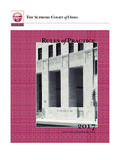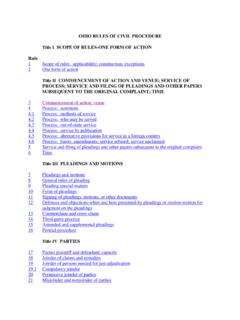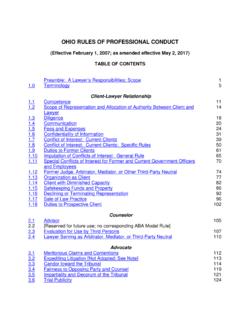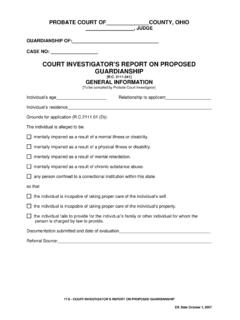Transcription of Felony Sentencing Reference Guide - Supreme Court of Ohio
1 Felony Sentencing Reference GUIDEThe Felony Sentencing Quick Reference Guide summarizes the statutory provisions governing ohio s Felony Sentencing scheme. The sections below outline the relevant considerations at each stage of the Sentencing process, and the Guide is updated as necessary to reflect new legislative revisions as well as Supreme Court of ohio opinions. Further information and instruction on Felony Sentencing is available through Reference to the Criminal Sentencing Commission s Uniform Sentencing Entry package and instructions, which will be hyperlinked within the Quick Reference Guide . REVISED NOVEMBER 2021 CRIMINAL Sentencing COMMISSIONOHIO65 SOUTH FRONT STREET 5TH FLOOR COLUMBUS, ohio 43215-3431 TELEPHONE: FAX: Sentencing Entry (USE) ..1 Purpose & Principles of Criminal Sentencing ..2 Seriousness & Recidivism Factors: Consider in Every Case ..3 Pretrial Diversion.
2 4 Intervention In Lieu of Conviction ..4 Discretionary Prison Terms and Community Control .. 5 Targeted Community Alternatives to Prison (TCAP) ..8 Technical Violation/Community Control Violator Caps .. 8 Mandatory Prison Terms ..9 Indefinite & Definite Sentencing ..12 Sentencing Considerations & Advisements ..13 Registration Requirements ..17 Financial Sanctions ..19 Release & Sentence Reduction Mechanisms ..20 Felony Sentencing Table .. 24 Felony Sentencing Reference Guide | Revised: November 2021 | sc . ohio .gov/boards/ Sentencing | Page 1 UNIFORM Sentencing ENTRY (USE)The complex, intricate process of Felony Sentencing in ohio makes ensuring clear, comprehendible sentences of the utmost import for the administration of justice and promoting confidence in the system. As such, Chief Justice Maureen O Connor asked the Commission to convene an ad hoc committee on uniform Sentencing entry (USE).
3 The committee developed a USE that prescribes the most clear and concise minimum language required to comply with Criminal Rule 321 and existing case law, and establishes standardized, common data essential for identifying relationships and trends common to all Felony Further, there are certain important elements that precede Sentencing but are not essential to the minimum language required for a USE especially in light of recent Supreme Court of ohio decisions and the ever-changing statutory provisions regarding Sentencing . Thus, the committee also developed companion method of conviction (plea) entries, as well as entries memorializing the other manners in which a Felony criminal case may be , throughout the work of the committee, there was a common thread to the discussion centered squarely on the notion of what the committee coined good civics. In other words, there are a number of standardized documents and notices that are used with regularity and recommended for use but not required by law for sentence or other disposition.
4 The committee agreed that the Commission should obtain these documents from individual jurisdictions and serve as a repository to make them approximately one year of work and collaboration with the ohio Common Pleas Judges Association, ohio Prosecuting Attorneys Association, Supreme Court of ohio , ohio Judicial Conference, ohio Clerk of Courts Association, ohio Chief Probation Officers Association, and ohio Felony Court administrators, among others, a package of documents for Felony Sentencing was endorsed, including: A USE; Method of conviction entries; and Good civics forms and notices. The goal, in part, was to design a living document that will be adapted as law, rules, and practices dictate. Accordingly, the Commission is monitoring legislation and Supreme Court of ohio case decisions to keep the USE and associated documents current with any necessary changes, notifying practitioners of those changes, and working with jurisdictions to provide training as the entry is adopted.
5 Judges and courts are in various stages of implementing the USE and associated documents. Additional information on the topics covered in the Felony Sentencing Guide can be found in the USE package instructions3. 1 For details, email The latest versions of the Uniform Sentencing Entry and the Method of Conviction and Good Civics forms are available at Sentencing Reference Guide | Revised: November 2021 | sc . ohio .gov/boards/ Sentencing | Page 2 Principles: Always consider the need for incapacitation, deterrence, rehabilitation of the offender, and restitution to the victim and/or the public [ (A)]. Sentences should be commensurate with, and not demeaning to, the seriousness of offender s conduct and its impact on the victim, and consistent with sentences for similar crimes by similar offenders [ (B)]. Courts shall not sentence based on the offender s race, ethnicity, gender, or religion [ (C)].
6 PURPOSES & PRINCIPLES OF Sentencing [ (A)]Overriding Purposes: To protect the public from future crime by the offender and others, to punish the offender, and to promote the effective rehabilitation of the offender while using the minimum sanctions that the Court determines accomplish those purposes without imposing an unnecessary burden on state or local government resources. The adoption of the package of Felony Sentencing documents is the first step to begin standardized, aggregate Felony Sentencing data collection in ohio the ohio Sentencing Data Platform. It provides the foundation to create a timely, accurate, comprehensive, searchable, and shared ( Felony ) Sentencing database to help inform decision making and give judges the tools and information needed to impose sentences in accordance with the purposes and principles of Felony Sentencing . We believe we can do this in a way that is efficient, reduces duplication, and does not fiscally or administratively burden local Sentencing Commission has partnered with the University of Cincinnati to develop the ohio Sentencing Data Platform, which includes a web-based application courts can use to create their Sentencing entries in USE format.
7 This application integrates with existing Court practice to minimize workload impact in creating a Sentencing entry. The application is currently being tested, with plans to roll the application out to additional courts in the summer of 2021. Courts and practitioners interested in more information on the USE package and the ohio Sentencing Data Platform can visit or contact:SARA ANDREWSD irector, ohio Criminal Sentencing Sentencing Reference Guide | Revised: November 2021 | sc . ohio .gov/boards/ Sentencing | Page 3 SERIOUSNESS & RECIDIVISM FACTORS: CONSIDER IN EVERY CASEThe Court must weigh the following factors, if present, as well as any other relevant . OFFENDER S CONDUCT MORE SERIOUS [ (B)] Injury exacerbated by victim s physical or mental condition or age; Victim suffered serious physical, psychological, or economic harm; Offender held public office or position of trust related to the offense; Offender s occupation, elected office, or profession obliged the offender to prevent the offense or to bring those committing it to justice; Offender s professional reputation or occupation, elected office, or profession facilitated the offense or is likely to influence others conduct; Offender s relationship with the victim facilitated the offense; Offender acted for hire or as part of organized criminal activity; Offender was motivated by prejudice based on race, ethnicity, gender, sexual orientation, or religion.
8 And In a domestic violence or assault case, offender is parent or custodian, the victim was a family or household member, and the offense was committed in the vicinity of one or more children other than the . OFFENDER S CONDUCT LESS SERIOUS [ (C)] Victim induced and/or facilitated the offense; Offender acted under strong provocation; Offender did not cause or expect to cause physical harm to person or property; and Substantial grounds exist to mitigate the offender s conduct, even if they do not constitute a . OFFENDER S RECIDIVISM MORE LIKELY [ (D)] Offense was committed while on bail, awaiting Sentencing , on Felony community control or post-release control (PRC), or after PRC unfavorably terminated; Offender has a history of criminal convictions or juvenile delinquency adjudications; Offender has not responded favorably to sanctions previously imposed in adult or juvenile Court ; Offender shows pattern of alcohol/drug use related to offense and doesn t acknowledge it or refuses treatment; and Offender shows no genuine.
9 OFFENDER S RECIDIVISM LESS LIKELY [ (E)] Offender has no prior juvenile delinquency adjudication and/or no prior adult conviction; Offender has led a law-abiding life for a significant number of years; Offense was committed under circumstances unlikely to recur; and Offender shows genuine . OFFENDER S VETERAN STATUS [ (F)] Felony Sentencing Reference Guide | Revised: November 2021 | sc . ohio .gov/boards/ Sentencing | Page 4 PRETRIAL DIVERSIONC ounty prosecuting attorneys are permitted to establish pretrial diversion programs under standards approved by the presiding judge in their jurisdiction pursuant to Programs and availability may vary by jurisdiction but are generally aimed at helping defendants with a low risk for recidivism avoid criminal conviction. Model diversion application and acceptance entries are available as part of the uniform Sentencing entry (USE) package. Pretrial diversion eligibility is determined by the charge or nature of the offense or offenses involved [ (A)(1-5)].
10 Defendants accepted into diversion must, in writing, waive their speedy trial rights, agree to tolling of the statute of limitations, and agree to pay any supervision fees established under the program [ (B)]. Victims of the criminal offenses and the arresting officers may object to offender s acceptance [ (C)]. Successful completion of the diversion program results in a dismissal of the charges against the defendant. Unsuccessful termination from the program results in the defendant being brought to trial on the charges [ (D)].INTERVENTION IN LIEU OF CONVICTIOND efendants who allege that one of four types of conditions were a factor contributing to their commission of the offenses with which they are charged may request that the trial Court grant intervention in lieu of conviction (ILC). If ILC is granted and successfully completed, the defendant may have the charges against them dismissed and are eligible to have those charges sealed as a dismissal [ ].













